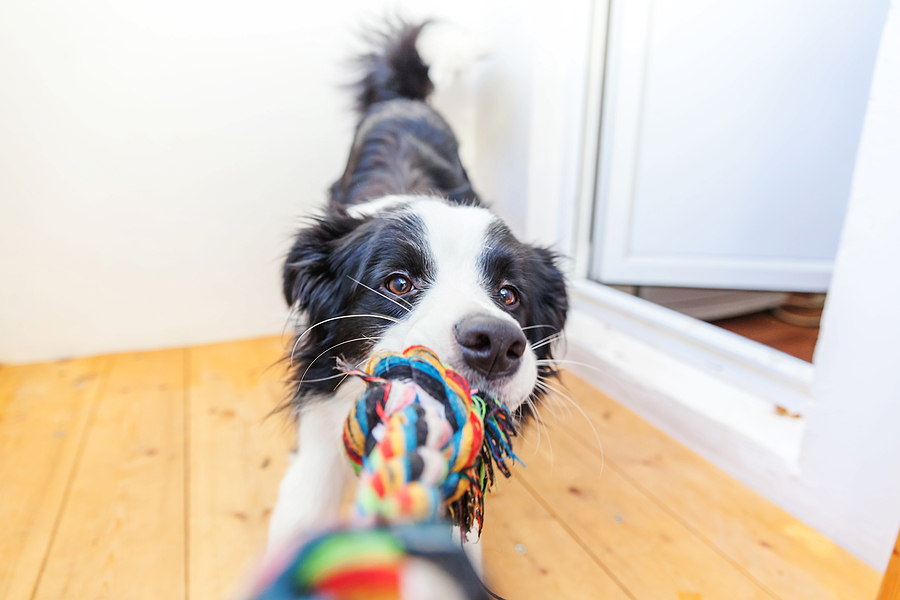Dogs everywhere seem to be afflicted with the zoomies these days. With the arrival of winter’s challenging weather coupled with the spike in COVID cases, many pet parents and their dogs are forced to stay socially distant, spend more time in our homes and cancel travel plans for at least the upcoming winter months.
That means some dogs struggle with cabin fever and stress.
“A dog with pent-up energy can become destructive, annoying, frustrated and needy,” says Larry Kay, coauthor of the best-selling The Big Book of Tricks for the Best Dog Ever, dog filmmaker, and co-host of the popular Positively Woof’s Dog Hugs show on Facebook. “With COVID, we are stuck at home with each other. Instead of seeing that as a negative, let’s find the gold goodies for our dogs and enrich our relationship with them.”
Your mission: make your home “zoomie” safe by channeling your dog’s cooped-up feelings in constructive ways while you are all stuck inside. Teaching your dog new tricks is a way to work your dog mentally and physically.
Kay, who shares his Los Angeles home with a high-energy dog named Spider, says, “Some dogs are so enthusiastic or ‘drivey’ that the challenge is to maintain focus during training sessions in the home. The key is to keep it positive and short and end with a successful jackpot, such as treats.”
He identifies eight strategies to address a dog’s bottled-up energy:
- Tone down a high-energy dog by having him perform low-energy activities, such as a series of sits and stays. Then have your dog pause in place by sitting up with raised front paws. Adds Kay, “Vary the activities in a training session so that your high-energy dog learns to follow your lead and focus on what’s next.”
- Deliver positive energy. “Your emotional state is key,” says Kay. “If you feel like you are losing your patience, take a breath, calmly look at your dog and try again. Dogs can feel our COVID frustration and stress. They are here for us as we are for them.”
- Turn unwanted behaviors into welcome tricks. Instead of reprimanding your dog when he jumps on you, start rewarding him when he sits. Then lure him to jump up in place. Say a fun phrase, such as “boing!” Reward him with a treat as soon as he leaps up in the air. If he tries to jump on you, place a baby gate between you to prevent this.
Kay also offers some fun indoor games to better deal with canine zoomies:
- Hide treats in magazines, towels, or newspaper sections. Start first by showing your dog a treat. Have him sit as he watches you ‘hide’ this treat in a towel, magazine, or newspaper that you crumple up. Then call him to ‘find’ the treat and praise him when he does. You can add more layers to bury the treat deeper.
- Turn your empty egg carton into a food puzzle toy. Cut off the bottoms of the egg dimples. Hide treats inside the carton. Use masking tape to close the lid and encourage your dog to open and retrieve the treats.
- Get your dog to help clean up. Place a toy in an open toy box (or cardboard box) and cue your dog to fetch it. When he lifts the toy out of the box, place your hand over the box and cue him to give the toy back to you. Mark it, let the toy fall in the box, and deliver a treat over the box. Gradually, you can add the verbal cue, ‘Clean up time!’ to get your dog to fetch toys scattered on the floor and put them in this toy box.
- Play a game of tug and release that features three tricks: grab, tug, and give. For high-energy dogs, start by showing him the tug rope and saying, ‘Tug!’ as you hold the rope tightly. When you pull-pull-pull, say, “tug-tug-tug.” Using two identical rope toys, teach your dog to release. If your high toy-drive dog is reluctant to drop the toy, lure him with a second toy to get him to drop the first one. Say, “good drop” or “give” when he drops it.
- Run the bases. In an open room, place four pillows a few feet apart. Have your dog sit on first base and using a treat, direct him to go to the second pillow, then to the third and then the fourth. Be with your dog to guide him to the next pillow to focus his motion.
This article was reviewed/edited by board-certified veterinary behaviorist Dr. Kenneth Martin and/or veterinary technician specialist in behavior Debbie Martin, LVT.








